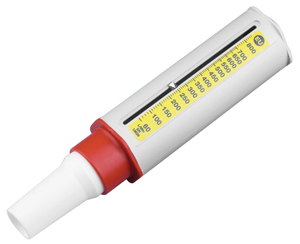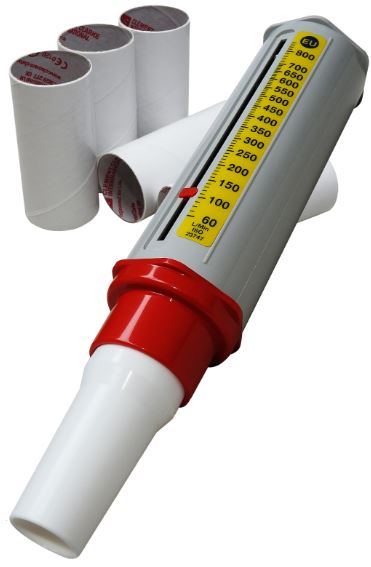PEAK-FLOW METER
Valid Article
PEAK FLOW METER, manual
Definition
A manual, hand-held instrument designed to measure only the maximum rate of expiratory gas flow from the lungs. It includes a tube for patient exhalation, easy-to-grip, and a calibrated scale that shows the value of the peak flow.
The device helps to discriminate the pulmonary status in routine tests performed in or outside of a clinical setting; it is also intended for periodic self-evaluation of the respiratory status of a patient, and to help in the treatment evaluation of patients suffering from chronic respiratory disorders (e.g., asthma, emphysema).
Specifications
Quality standards
Technical specifications
- Plastic tube or device with pointer
- European scale (litres/minute) written on the peak flow meter
- Linear graduation from +/- 60 to 840 l/min
- Accuracy: ± 10 l/min
- Dimensions: ± 100 x 60 x 240 mm
Supplied with the Article
- autoclavable plastic mouthpiece
- optional: single use cardboard mouthpieces with one-way-valve (to prevent the patient from breathing in any of the previous patient's exhaled breath), box of 100 mouthpieces
Instructions for use
Can be used in children as well as in adults.
- Insert the mouthpiece into the flow meter
- Check that the pointer is at zero
- Stand up if possible
- Hold the flow meter horizontally so that the fingers do not stop the pointer from moving
- Take a deep breath
- Place the mouthpiece into the mouth
- Blow as hard and fast as possible (blowing a long time doesn't help)
- Repeat this attempt 2 times and write down the highest reading
- Dispose of the cardboard mouthpiece after use
Keep a sufficient stock of cardboard mouthpieces (see related articles below)
Maintenance
The plastic mouthpiece can be autoclaved.
The peak flow meter is not autoclavable and must be cleaned and disinfected with a detergent/disinfectant solution for surfaces / non-invasive medical equipment. Prepare use-solution in concentration required. Always read the label and product information before use. Do not mix with other products. Make sure to wet the surfaces completely, use a wipe or towel, keep them wet for the whole exposure time.
Shake well to ensure any trapped air is expelled. Rinse and let dry naturally.





![[KMEDMHCE23-] (mod OPD) MEDICAL EQUIPMENT 2021](/web/image/product.template/574347/image_256/%5BKMEDMHCE23-%5D%20%28mod%20OPD%29%20MEDICAL%20EQUIPMENT%202021?unique=2864cd2)
![[KMEDMHWE33-] (mod ward) MEDICAL EQUIPMENT 2021](/web/image/product.template/574356/image_256/%5BKMEDMHWE33-%5D%20%28mod%20ward%29%20MEDICAL%20EQUIPMENT%202021?unique=010fcc3)
![[KMEDMSUP05E] (IEHK 2024 suppl. module) SUPPLEMENTARY EQUIPMENT UNIT](/web/image/product.template/583179/image_256/%5BKMEDMSUP05E%5D%20%28IEHK%202024%20suppl.%20module%29%20SUPPLEMENTARY%20EQUIPMENT%20UNIT?unique=0feee45)
![[EMEQPEFM1MP] (peak flow meter) MOUTH PIECE, cardboard, s.u.](/web/image/product.template/572930/image_256/%5BEMEQPEFM1MP%5D%20%28peak%20flow%20meter%29%20MOUTH%20PIECE%2C%20cardboard%2C%20s.u.?unique=e9de7da)